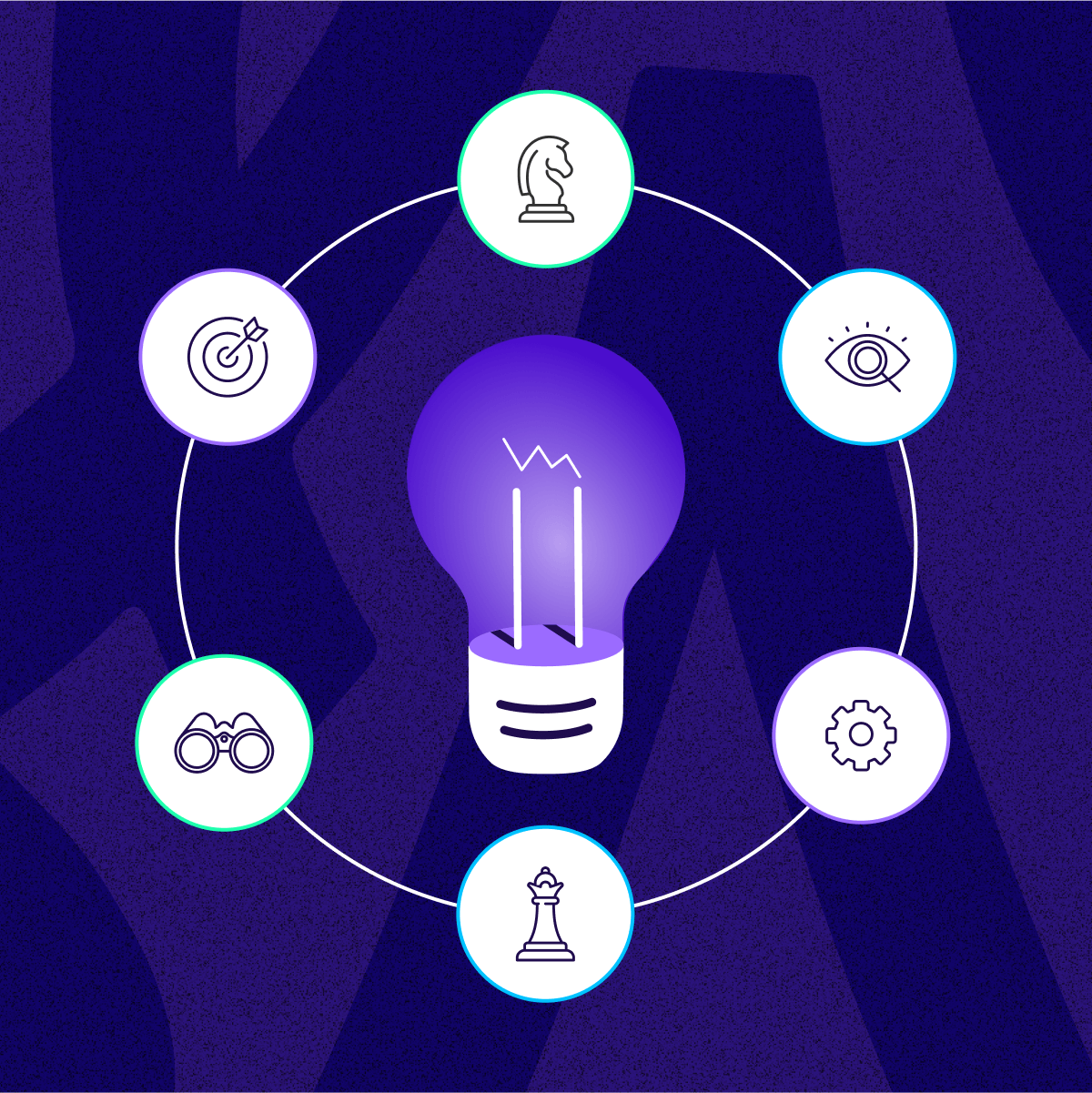
Mobile marketing trends predictions for 2022 – the director’s cut

Crystal balling digital marketing trends is always a daunting task.
Because the implications of the 2021 ecosystem-sweeping privacy revolution are so vast and there are so many unknowns, trying to anticipate how things will unfold is no cakewalk. But – that doesn’t make predicting any less fun.
To gauge the hottest key trends of 2022, we gathered the industry’s top experts and picked their brains on the most trending mobile marketing topics that every digital marketer has to know:
- How will user privacy affect campaign budgeting, remarketing, and self-reporting networks?
- What role will M&A play in the race towards 1st party data ownership?
- To what extent will data science and non-SKAN measurement replace traditional measurement and optimization in face of a data-limited reality?
These are a few of the head-scratching questions our experts addressed, so you can better prepare for what is shaping to be a fascinating 2022.
So buckle up! Let’s dive in.
3 – Let the games begin – Gaming trends
4 – Put your artistic cap on – Creative trends
5 – Nailing cross-channel strategy – Web-to-app trends

1 – A view from above
What impact will privacy have in 2022 on budgets and SRNs? Who will win the 1st party data race and how will data clean rooms come into play? Will consent rates rise? The burning questions are tackled head on!
Budgets shifting amid privacy changes | Thomas Petit, Mobile Growth Consultant
Marketers have been revisiting their marketing mix and shifting budgets across platforms and networks, who will also be some of the beneficiaries from the higher scale. At the same time, Facebook and other SANs will continue to take the biggest hit from IDFA deprecation.
Competition for Android inventory has grown since June with ATT being enforced, and the pressure on prices is putting app marketers in a tricky situation.
One particular network benefiting from the shift of budgets is Tiktok. Its ever growing user base, associated with what might be a better interpretation of SKAN data – positions TikTok’s as a particularly strong player in the year to come.
When users flock to new places, performance advertisers tend to follow suit quickly, and I can only see competition continuing to explode as bigger brands and advertisers finally join the party in 2022.
Expect organic reach to be lower as ever, in a similar manner to what happened to Instagram many years ago.
You don’t know what you don’t know – the era of data clean rooms | Saikala Sultanova, Mobile Growth Marketer at UA Society
2022 will be the year of discovering new ways of measuring marketing effectiveness. I like the idea of Data Clean Rooms (DCRs), a tool that could give us insights from user-level data without user-level data access.
We will learn from other industries that had to work with an opaque data environment for decades, and try to move towards a clearer data-driven approach.
Within Gaming, however, we will have to learn how to move away from laser targeting and towards creating new ways that could work for our businesses.
Some opacity will be there by design, as there may not be a way around it. BUT – as Socrates said – “you don’t know what you don’t know”.
Whichever DCR we end up using, it will help us identify useful information we wouldn’t otherwise be able to access. It will also act as a catalyst for working with differently-shaped data to measure our future marketing activities.
I’m personally curious and excited to work on building new ways to move forward with this approach.

Most users will agree to give apps their IDFA data | Sandra Wu, Director of Growth at Himalaya
We’ve seen our IDFA collection rate slowly climb back up on its own without many product changes, albeit very slowly (one percentage point every two weeks). At some point, App Tracking Transparency prompts will be treated the same way as cookie banners, and become widely accepted.
Why? I think the attitude towards personalized ads will change. More consumers will begin to understand that personalized ads might not be a bad thing. In Canada, where I live, without IDFA, the only ads you get are from casinos, Netflix and Viagra. It’s so spammy that it might just be enough for people to reconsider their choices when they upgrade their iPhones.
What does this mean for mobile marketers? Keep iterating on your data privacy prompts. The more you can prove that personalization can positively influence a user’s experience, the more likely they are to hand over their IDFA.
Data ownership and mastery will be gold | Claire Rozain, UA Team Lead at Rovio
Sharing your data – or not – is going to be even more of a topic, because the value of this data is going to be even higher with privacy changes continuing to unfold.
As companies expand their portfolios by acquiring other brands, they’re also acquiring access to more data and ways to activate it, which is going to be a real competitive advantage in 2022.
Those who will be able to read learnings from portfolio level data and leverage it by retaining and cross promoting users – are going to lead the market. Supporting this trend, machine learning will continue to be developed in Gaming to enable a more personalized user journey – as Netflix currently does.
Decrease in duopoly’s market share | Shamanth Rao, CEO growth marketing agency RocketShip HQ
As iOS 15 deals a blow to the self-attributing nature of the bigger networks by allowing advertisers to access their own raw postbacks, Facebook and Google will no longer be able to claim the conversions and the value that they historically have done, and marketers will move budgets away: to SDK networks and to the smaller social channels.
Already, many advertisers have begun to go down this path, and we expect that this trajectory will be accelerated in 2021.
M&A and the race to 1st party data | Thomas Petit, Mobile Growth Consultant
The brand consolidation in adtech was predicted, but its scale and depth has gone far beyond anyone has imagined. Ad networks became game studios and vice versa, adding capabilities around measurement, creative production, audiences, and analytics.
There’s a fierce race towards 1st party data going on and it seems to be unstoppable, so definitely expect it to go on. But at some point, one has to wonder, who will be left to be acquired?!

2 – The skills of tomorrow
To what extent will data science and non-SKAN measurement replace traditional measurement? Learn about the skills marketers need to add to their arsenal to ensure growth in the age of privacy.
Data science who? | Andre Kempe, Founder at Admiral Media
Right now, digital marketing is in a continuous transitional period. The massive amounts of big data gathered aren’t available anymore or will disappear soon. It became very hard for marketers to support their decisions with data after the iOS14 changes, and data-hungry marketing teams have been put on a diet.
With this change, teams went from needing a doctorate degree data scientist back to ‘real marketers’ who focus on brand growth, incorporating awareness into performance marketing plans, measuring the incremental value of the conversion funnel, and crafting awesome creative ads with fewer data.
These new privacy rules resulted in fewer data to analyze, and everyone needs to adapt to using fewer data in their decision-making. However, there are more and more trends for marketers to keep up with, including Marketing Mix Model (MMM) and other techniques that will help in allocating budgets efficiently to maximize return on ad spend (ROAS).
3 core areas for buyers | Thomas Petit, Mobile Growth Consultant
In parallel, the skills required to run user acquisition keep shifting, as the typical media buyer tasks get replaced by 3 core areas of expertise:
- Ad creatives management as the primary lever for campaign performance
- Data science to interpret the complexity of measurement in a world with multiple but partial sources of truth
- The intersection of acquisition & product through onboarding & monetization experimentation.
Many app marketers are also rediscovering the joys & pains of working on the web in parallel, as being able to operate on both fronts can be beneficial to ensure a holistic marketing mix.

Marketers to embrace more non-SKAN measurement
Shamanth Rao, CEO growth marketing agency RocketShip HQ
With iOS reporting-as-we-know-it broken for the most part, thanks mainly to the idiosyncrasies of the SKAdNetwork timer and the opacity of Apple’s privacy thresholds, marketers will become increasingly comfortable with measurement outside of SKAN, using probabilistic measurement, modeled conversions, and incrementality.
Of these methods, marketers will increasingly embrace incrementality-based reporting as a source of truth, using methodologies that range from basic spreadsheet-based models to more sophisticated statistical analyses.
Gabriel Sampaio, Marketing Science Lead at Loft
There is no app marketer in the world who has not spent 2021 dreaming about terms like SKAN, IDFA, ATT, iOS 14.5. In fact, remarketers are still having nightmares about that.
Privacy is a no-way-back journey and we will definitely see that being exhaustively discussed throughout 2022. Google, for example, already announced that it’s new Play Store data privacy section will go live in February 2022.
Blockchain will also become a valuable resource for digital identity, expanding its horizons beyond the successful Crypto’s market, adding some spice to the discussion.
UA managers doing sales? | Simon Lejeune, Senior Director of User Acquisition at Wealthsimple
User acquisition is losing influence within companies. Lots of businesses have been acquisition-driven, and performance sometimes rules marketing departments.
And despite being able to easily demonstrate business impact, unlike other teams like PR, Product Marketing, or Brand – acquisition teams will have to work even harder to persuade skeptical execs to spend their money on ads, hire more people or prove their value.
ASO is an ever evolving creature | Gabriel Kwakyi, Director of Acquisition at Phiture
ASO will continue to “modernize”, and by that I’m referring to the fact that other signals beyond keywords continue to grow in their influence of organic discovery.
As Thomas Petit covered in his keynote at the first ASO Conference, simply doing keyword optimizations is no longer an easy ticket to ASO growth.
In modern ASO, it’s still important to optimize your keyword metadata, especially as it relates to localization. But more and more, the job of an ASO team will shift towards managing other factors.
In both stores, A/B testing or CRO (conversion rate optimization) has seen its level of importance over keyword optimization grow, and thankfully we now have a proper A/B testing tool in iOS Product Page Optimization to help with that.
Both stores – Apple’s Custom Product Pages and Google’s Custom Store Listing – have also invested into new tools to customize the App Store landing page based on who the user is (new/returning), and where they are coming from (acquisition source).

3 – Let the games begin – Gaming trends
What role will the metaverse play in the gaming app space? Will the M&A frenzy continue? Will 2022 be the year of blockchain gaming? Find out what the experts have to say.
Brands are back | Tiffany Keller, Director of Product & Jacopo Guanziroli, Head of Ad Ops at SYBO
Privacy protection is the move that will bring household brands into gaming universes. This will happen twofold:
- Platform regulations will drive adoption of contextual segmentation, while finally rendering brand ads competitive in game publishers’ ad supply.
- Brand interest in gaming will open the market to new ad formats, and branded live ops will be optimized for in-game engagement.
From an ad monetization perspective, we foresee that it will become table stakes for gaming developers to segment players according to preferences around privacy.
Publishers relying mainly on ad networks with better targeting based on identifiers were impacted by the changes of iOS 14, so segmentation has become key to keep serving targeted ads to users who are willing to share their consent.
In parallel, contextual advertising will continue to become more important. The fact that big players like Facebook are looking into it – speaks for itself. Contextual advertising doesn’t rely on picking out potential gaming whales using targeting, so naturally the CPM is lower.
This means brands will have an easier time competing with other contextual ad inventory shown in games, and will win auctions to be shown to the player more often than when mixed into targeted ad segment inventory.
The Metaverse will change game experiences
Gabriel Sampaio, Marketing Science Lead at Loft
With Facebook becoming a Metaverse company, we’re going to see the virtual reality (VR) trend grow even more. We should be prepared to see a boost in metaverse apps emerging, especially in the gaming industry.
We can expect a lot of new launches and developments, and, on the business front, monetization solutions for those apps, with a large variety of strategies. In that sense, a good in-app advertising strategy will be (literally) game-changing for this industry.
On top of that, with a broad reach for 5G in the horizon for the next year, it will likely become the new standard for mobile technologies in many areas, unleashing never-ending possibilities and allowing a new generation of apps to make the best use of this technology – mainly AR and VR products.
Smooth streaming in 4K? Can’t wait!
Claire Rozain, UA Team Lead at Rovio
The Metaverse will push forward even more cross-platform game experiences and encourage publishers to build mobile and AR products to support this trend.
More than ever, games will shape a new world, creating new and inspiring experiences without boundaries in a blockchain environment.
The online world will be all yours, and this is the prediction I’m the most excited about! It’s either going to penetrate the market in a completely innovative way or fail completely, with the potential to completely reshape the mobile space, and even our lives.
Tatsuo Sakamoto, Head of Japan Sales at Moloco
Japan might be one of the leading countries in the global VR world, as it’s represented by “virtual markets” (like the Comic market on VRChat), which is already an ongoing trend.
My personal opinion is that as VR, AR, and the Metaverse become more and more major, people will start behaving in the same (or similar) way in virtual space as they do in the real world.
On the monetization side of things, end user subscription modeling would be the main monetization at the initial phase of these new technologies, rather than profits via advertising.
Abhay Shah, AVP of Marketing & Communications at Nykaa
VR and AR could finally see the start of mass adoption towards the fag end of 2022, courtesy of the Metaverse. Finding relevant virtual real estate could be a way forward for digital branding. Digital VR experiences will have a significant impact on brand salience and love.
Go big or go home | Tiffany Keller, Director of Product & Jacopo Guanziroli, Head of Ad Ops at SYBO
As the gaming sector grew 25% YoY in installs and 40% in revenue compared to 2019, Big Tech now wants a piece of the pie.
Gaming publisher consolidation will influence SaaS companies at large to optimize their services for gaming.
M&A will drive all-in-one GaaS (Games as a Service) offerings and new game publishing verticals in SaaS companies. And in addition, M&A of new ad format startups will better serve game publishers in a privacy first market.
Mergers and acquisitions have happened very often this year, and we don’t see this trend slowing down in 2022. Companies want to consolidate their position but also enter new spaces within the mobile industry.
The race for better results is not only passing through the relations between publishers / ad networks / advertisers, but extended to different kinds of tools: analytics, measurement, ad quality dashboards and other services.
For this reason, SaaS companies will offer an “all-in-one” software suite to fulfill every possible need in one place.
When SaaS companies build game engines, analytics stacks, and mediation platforms – they have more visibility into the drivers of gaming success, and will capitalize on that by building or publishing their own games. We have already seen Ironsource start developing games, informed by their knowledge of winning UA strategies and finding low CPIs.
We have also seen Applovin finding tremendous success by developing games at first, and then making big moves in the Adtech space. We will continue to see the line between game publishers and SaaS blur, as finding moderate success in games becomes more of a science than an artform.
For Big Tech providing services to game publishers, it’s also strategic to develop a few small games as their own testing ground or R&D space. We predict one of the games published by Big Tech will finally be considered a moderate “hit”, at the very least.
Games published by SaaS-first companies will usually have an ads-focused business model that can be best served by any existing SaaS infrastructure or core competencies.
This is why we also predict that some of the new ad formats like billboards or audio ads mentioned in the previous prediction will be acquired by SaaS companies to complete their game services suite. This would give their mediation services or ad networks an edge over other Adtech providers in what’s already a frothy market.
Whether it will be the smaller SaaS players focused on gaming, or the Big Tech bastions that want to grow their foothold in gaming – will become clearer over the next year.

Web skills for blockchain gaming | Matej Lancaric, User Acquisition Consultant for Mobile Games
The persona-led creatives is a trend everybody is talking about now thanks to iOS 14. Thing is, personas and motivations were already here a long time ago, but I guess it just wasn’t very popular to talk about back then.
So let’s focus on something else. Adapting hyper-casual game concepts to your game creatives is going to explode next year.
I’m pretty sure that you’re already familiar with all the ASMR videos on Youtube, which lead into the game development of the ASMR Slicing hyper-casual game by Tricky Tribe – my friends from Slovenia. This ASMR game was a big hit in the United states and even reached first place in number of downloads for a couple of weeks.
I’m also pretty sure you saw different games like CoinMaster starting to slice their coins, so we’re not talking just about ASMR slicing anymore, as seen by Tangle Master 3D, Crowd City, with new ones popping up every day.
Rewarded ads will continue to reward | Caglar Eger, Director App Store Relations / Partnerships & Corporate Development at Goodgame Studios
In the early days of mobile marketing, incentivized User Acquisition was seen as an effective tool to manipulate rankings. Ideally, this method helped to increase the amount of organic downloads.
Nowadays, however, incentivized User Acquisition has evolved into Rewarded User Acquisition, which is also widely known as Cost Per Engagement.
After the introduction of so-called Offerwalls on diverse channels, Adtech companies started engaging players with (additional) playtime or rewarding users for reaching certain in-game goals – with gift cards or other in-game items.
The recent acquisition of Tapjoy by IronSource showed us that there is a huge market in this spaceת and I think we will see more and more companies increase their CPE spendings in the future.
Consequently, I’m certain that CPE will play a bigger role in the UA strategy of many gaming companies.
Expanding from regional to global competition | Motoi Sato, Chief Executive Officer at MOTTO
The mobile gaming market grew dramatically in 2021, especially in Brazil, Russia, Indonesia, and Mexico. On the other hand, in regions such as the US, Japan, South Korea, and the UK, download rates have plateaued and are expected to decline year over year.
In Japan specifically, user acquisition for newly released game apps has stagnated at around 50% compared to a few years ago.
As a result, developers, especially in Japan, Korea, and China, are faced with the need to expand their business overseas. 2022 will see the start of a full-scale global competition and global marketing efforts.
In parallel, we foresee the opening up of external payments for apps. If this happens, the profitability of the app market will change, and funds will be invested in development and advertising more aggressively than ever before, leading to further evolution of the mobile business.

4 – Put your artistic cap on – Creative trends
Who doesn’t want to go viral? The experts lined up the most essential tips for creating compelling campaigns using the most consumable channels.
Storytelling in mobile ads | Peter Fodor, Founder & CEO at AppAgent
Today’s casual games are like teenage romance novels – built on cliché, simple characters, and predictable plots.
With more and more games offering pretty much the same experience and even worse, looking similar, the role of engaging and more sophisticated storytelling will take the 2022 mobile space by storm.
The captivating narrative is not only a marketing tactic. The best games will become more like a hybrid of movie and interactive experience. Just a reminder, the same happened in PC and console gaming 15 years ago. Since then, the time spent playing is also a lot like watching and living in some type of deeper story.
Strong narratives and 3D animation skills have become an integral part of a marketing creative team’s skillset. Communication and creative teams should develop rich worlds, sophisticated characters and intimate relationships.
Those should be tested first, to provide gaming teams with a direction that will engage their audience and grow their intellectual property for years to come.
On that front, marketers, designers and developers will cooperate much more than ever before.
Creative – the main optimization lever? | Piyush Mishra, Growth Marketing Lead at Product Madness
As we move towards a privacy-centric world, the number of levers for optimization will continue to reduce. I still believe that we will receive enough data to innovate on the ‘targeting side’, although measurement will continue to be somewhat limited.
Given the scenario above, Creative will become one of the most important levers for optimization. This could potentially include the creation of a new innovative format with a renewed focus on it.
Especially with iOS 15 changes, the entire flow – from contextual marketing, to an informed creative for a particular audience, to a consistent landing page – would find increased relevance.

TikTok as a creative engine | Simon Lejeune, Senior Director of User Acquisition at Wealthsimple
More and more apps make ads for TikTok first, and then use them on other channels. TikTok is setting the agenda for ad creatives. We all know “Don’t Make Ads. Make TikToks”, which is a simple and brilliant strategy.
I can see more brands moving from traditional, boring UGC ads to truly entertaining video ads made by influencers. Giveaways, stunts, music videos, skits, dance moves, etc.
Your ad library might end up looking like a teenager’s YouTube channel!
Brand-driven ad formats will emerge | Tiffany Keller, Director of Product & Jacopo Guanziroli, Head of Ad Ops at SYBO
Exploring new ad types such as in-game native, branded liveops, audio ads, or in-play billboards – could be another interesting solution for publishers.
Due to privacy changes affecting the efficacy of ads in limited tracking segments, for games to drive effective UA – they will need to show more ads to win players over.
This, however, creates a problem for game publishers, because players can only watch so many ads before game engagement suffers. This makes emerging ad formats that don’t distract from gameplay such as branded liveops, rewarded audio, or billboard ads – more attractive to both publishers and brands alike.
These formats are more branding than performance-driven, making them an attractive supply that household brands can compete in, driving the growth of both demand inventory and publisher adoption of these formats.
The year of SMS marketing | Annica Lin, VP of Growth Marketing at Sable
The evolution of mobile commerce has made SMS marketing more personalized, dynamic and engaging than ever before. According to a research from Yotpo, 89% of mobile consumers want to receive text messages from brands, while mobile consumers spend 2X more time texting than emailing.
Moreover, SMS marketing technology has evolved throughout the years. It’s no longer broad and text only. It could include an image or a gif, a landing URL or CTA, just like a paid social ad in an SMS format. The difference is that SMS requires the consumer’s consent.
Brands will need to provide value upfront in exchange for consumer’s trust. However, its high open rate and conversion rate – will eventually pay off.

5 – Nailing cross-channel strategy – Web-to-app trends
Cross-media strategy is nothing short of mandatory. What role will web-to-app marketing play, and where should you focus to ensure growth and maximize your investment?
App only companies will tap into web | Annica Lin, VP of Growth Marketing at Sable
2021 has been a challenging year for mobile app marketers due to the release of iOS 14, 14.5 and SKAdNetwork that uses different attribution rules. 2022 might be even more challenging for mobile app marketers.
The old-school web marketing might be able to provide a breath of fresh air for app markers by creating a mini web onboarding flow, or a full web onboarding funnel, and then guide users to have full product engagement via the mobile app.
Web marketing provides more capabilities when it comes to measurement and attribution, while enabling app users to fully engage with the app after onboarding.
Web campaigns are king. Again? | Andre Kempe, Founder at Admiral Media
Over the years, user acquisition tactics have evolved to become increasingly complicated and sophisticated. Every UA and Growth specialist used to heavily rely on mostly automated app install campaigns to achieve their goals.
However, things have changed (again).
Apple’s ATT took us 3-5 years back into the past, and the bad news is that costs didn’t come with us. Ad prices on Facebook CPM increased 4x in 2021 alone. In addition to that, app tracking & IDFA are gone for good, and businesses are still paying 30% App Store tax on both new subscriptions and renewals.
Now, we’re back to when it was a good strategy to have web funnels where you acquire new users on cheaper channels across the web, measure and optimize the funnel – and only send users to your app when they’re ready to buy.
Growth leads and UA specialists are now running web acquisition campaigns, which can also save them the 30% App Store fees (now 15% or even 10% for some businesses) to keep up with the rise of CPMs, if they manage to get users to subscribe on the web.
Yes, this is still complicated due to web-to-app tracking limits. However, with the amount of available data being limited everywhere, the web-to-app approach has certainly become more attractive again.
Google & Apple may have undercut this development of advertisers jumping on web funnels with their recently lowered fees, but only the future will tell if this was enough.

Web is attractive despite unknowns | Thomas Petit, Mobile Growth Consultant
An interesting trend has been the comeback of the web for app advertisers, at least outside of gaming.
Enticed by possible lower fees and the hope of improved attribution, subscription apps in particular have shifted parts of their UA attention in efficiently capturing users on the web, before redirecting them to the native app where there’s a better experience and retention potential.
There are some unknowns in this equation, between other changes coming on the cookie side as well as the full effect of Apple’s private relay, but this is still an interesting trend to follow – after progressive web apps failed to disrupt the App Stores in the last years.
Figure out how to bring web users to the App Stores | Caglar Eger, Director App Store Relations / Partnerships & Corporate Development at Goodgame Studios
The web can play a big role in post-IDFA. But why is that? It’s because the web allows you to collect user data before sending them to the App Stores. The flexibility you have on the web is tremendous, and you don’t have to rely on App Store changes or regulations.
In addition to that you also need to keep in mind that web-based games were already out there before mobile gaming took over. There is a lot of web marketing expertise out there in the market, but it’s crucial that you figure out how to drive these users to the App Stores.
To achieve this, you may need to be experimental and creative.
Marketers to up investment in web flows | Shamanth Rao, CEO growth marketing agency RocketShip HQ
As SKAdNetwork continues to be challenging and as platform performance erodes on app install campaigns, marketers will make significant investments in web based flows, which could range from simple landing pages that send users to App Stores, to flows that completely onboard a user on the web before having them download the app.

6 – General trends
Remarketing, social commerce, single-purpose funnels. Which mobile marketing trends will shape the coming year?
Apple will lower their commission for all apps to 15% | Sandra Wu, Director of Growth at Himalaya
Google made a pivotal move last month by lowering their App Store commission from 30% to 15% for all apps, an exception that was only made to low revenue players in the past.
Apple has similar rules for apps that make less than $1M per year, who only pay 15% vs. the enormous 30% for everyone else. However, I think this will be applied to all apps very soon.
The tech giant lost an important lawsuit against Epic Games earlier this year and is no longer allowed to penalize apps for getting around in-app payments by emailing offers to their users. This precedent could just be what makes them realize that they charge too much and will lose business if they don’t lower their fees.
Although this cutback might seem generous, it’s still nothing compared to the 3% commission charged by the likes of web payment solutions like Stripe. Apps will double down on their CRM sale efforts now that Apple can’t discourage web redirections.
But just wait, app flow lifetime values will look much better, very soon.
Lead capturing + lifecycle marketing = new remarketing | Annica Lin, VP of Growth Marketing at Sable
Retargeting campaigns used to be marketer’s “secret weapon” to reduce paid CPA. With at least 6 in every 10 iOS users rejecting tracking, this significantly reduces the amount of available data for remarketing campaigns, lookalike campaigns, and more.
In 2021, some companies already started optimizing their sales funnel by moving user information capturing to earlier steps so they can collect leads from prospects, use lifecycle marketing to continue nurturing leads, and then generate sales or conversions via lifecycle marketing.
In 2022, companies will place a bigger emphasis on lifecycle marketing to make up for the reduced efficiency from remarketing campaigns.
Fintech is everywhere | Gabriel Sampaio, Marketing Science Lead at Loft
Fintechs are helping people to manage their personal finances, invest in stocks, manage digital wallets, payment methods, and cryptos, leading a global revolution on the relation between people and their money.
Despite having several alternatives available (with more to come, for sure), we can expect high competition raising the bar of the market, and facing very demanding customers.
In 2022, providing finance services through apps will not be enough: you will have to be good at doing that. The best will survive!

Single-purpose funnels | Peter Fodor, Founder & CEO at AppAgent
The introduction of custom product pages and product page optimization by Apple is a “relevancy gamechanger”.
For the first time since the introduction of the App Store in 2008, marketers can connect the messaging and design of the first impression – be it an ad on Instagram, newsletter or a content ad on the Wall Street Journal – with the store page in order to create a consistent user journey.
Consumers finally won’t be confused by generic product presentations. If done right, page visitors will more likely convert and install your app or game.
On the other hand, this opportunity will require a strong marketing strategy, prioritization, and significant investment into asset production and testing.
Those who will set a systematic approach, quickly produce screenshots for testing and effectively evaluate where such effort pays off, will see the rise of the conversion rate and boost their ROI.
Social commerce will make waves | Abhushan Sarraf, Senior Manager at Marketing Hotstar
One of the biggest trends would be in the sector of Social commerce with people looking for better deals and a way to earn money. This will bring in the next 100 Mil audiences out in the open into the mainstream in the next 2 years. Mobile marketing will play a big role in educating people on this.
Social commerce is not an Indian phenomenon but will be an excellent boost for India mainly – because of the next 100Mn-200Mn new to internet users. Social Comm in China easily accounts for 13-15% of eComm retail sales through channels like WeChat etc. (including multi-level channels).
The Global Social Commerce Market has been pegged to reach $2.9 Trillion by 2026. US & China would easily lap up to 50%.
China is pegged at $200 Bn (of the $600Bn total world market), which will reach $1.5Tn status by then. India is next in line in terms of potential. Still, it would have a very high growth potential due to the new Internet audiences from T-2/3 cities, the second highest Internet users, and the highest Facebook users.
The CAGR would be ~30% for the next 7 years, which seems to be very a aggressive growth rate.
Abhay Shah, AVP of Marketing & Communications at Nykaa
Content to commerce would continue to rule and attract dollars in 2022, and advertisers would up their content game primarily to target Indian audiences.
Short video platforms would attract bigger marketing dollars for new customer acquisition. TikTok for 2022 will continue to rise and probably be a challenge to most social apps.
TikTok is here to stay, while the short video format is only growing.
It’s a bird! It’s a plane! It’s Super Apps! | Gabriel Sampaio, Marketing Science Lead at Loft
Most of the app companies are putting a lot of effort in finding new solutions to keep users engaged, discussing and developing new features and cross partnering with other solutions.
As a result, banks are becoming marketplaces, marketplaces are becoming Fintechs, social networks are becoming digital wallets, retailers are becoming one-stop-shops, last-mile on-demand delivery services, and so on.
Yes, WeChat is the benchmark and it’s been there since 2011, but the trend is a mass consolidation across the world and several markets, specially in fast digital growing regions such as Latin America and India.
Becoming a super app definitely addresses the retention concern, but it’s a challenge to keep its value proposition, while maintaining a good UX and a satisfying operation.
Key takeaways

2022 is shaping up to be an action-packed year on all marketing fronts: from web-to-app strategies, SKAdNetwork and IDFA-induced limitations, through continued M&A that will lead to the creation of more 1st party data fortresses, and down to data science, data clean rooms, and non-SKAN measurement taking front stage.
There’s so much to look forward to as we embark on what will undoubtedly be a pivotal year in digital and mobile marketing.
While we all hold our breath in anticipation of how the market will play itself out in the coming months, keep in mind that we’re all in this together. Key players across the industry are working relentlessly to ensure our ecosystem continues to reinvent itself – and even flourish – during these uncertain times.
So fasten your seatbelts and enjoy the crazy ride ahead!





